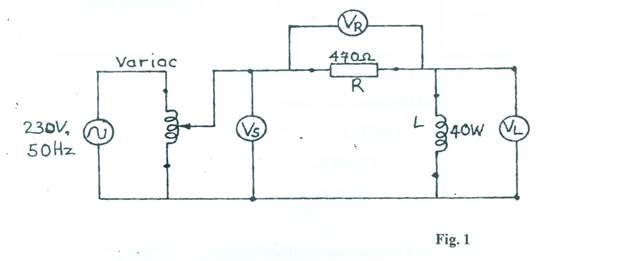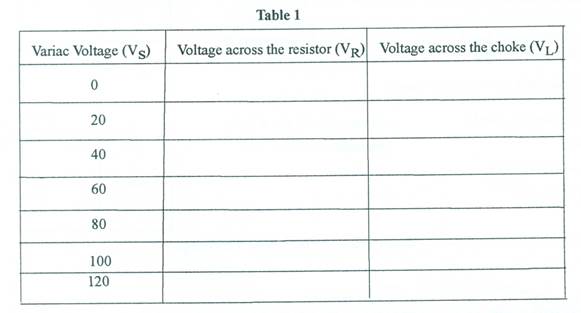Question 1
AIM: To determine the phase angle in an RL a.c. circuit

- Connect the circuit as shown in Fig.1.
- Ask the supervisor to check the circuit connection.
- Fill in Table 1 as appropriate in this booklet as presented below.

- Connect the variac to the mains supply and switch on.
- Adjust the variac to read 0V on voltage VS.
- Repeat and record the corresponding values of voltages VR and VL.
- Repeat steps (e) and (f) for the other values of voltages VS in Table 1.
- Plot a graph of voltages VR on the horizontal axis and VL on the vertical axis
- From the graph, determine the phase angle.
- At VS = 60V, calculate:
- VR + VL;
 )
) - Briefly comment on your results in step (j)
Observation
The expected answers were:
TABLE 1
VS(V) |
VR(V) |
VL(V) |
0 |
0 |
0 |
20 |
10 |
12 |
40 |
24 |
28 |
60 |
37 |
47 |
80 |
47 |
55 |
100 |
59 |
70 |
120 |
72 |
85 |
Correct readings for VR
Correct readings for VL
Correct libeling of axes
Reasonable scale
Plotting of points
Line of best fit
Expression ![]()
Correct substitution into expression
Correct answer
Phase angle
(xi) At Vs = 60V,
(A) VR + VL = 37 + 47
= 84V.
(B) ![]() =
= ![]()
=![]()
= ![]()
= 59.82V.
(xii) Reasonable comment on (xi)
e.g. The arithmetic sum is different from the algebraic sum.
The question required candidates to use the provided apparatus to connect a circuit, take readings, plot a graph, perform calculations and make comment. The circuit was connected but inaccurate readings were recorded in most cases.
Candidates were unable to calculate the required angle were blank in commenting on the results they obtained. Performance was generally poor.
